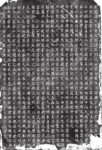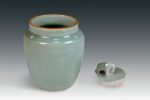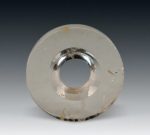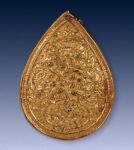 Archaeologists have discovered a double tomb of a lord and lady of the southern Song Dynasty (1127–1279) in China’s southeastern Zhejiang province. The tombs were unearthed at a contruction site in Qingyuan County in 2014 but the findings have only now been published in English in the journal Chinese Cultural Relics, a translation of the Chinese-language archaeology journal Wenwu (Cultural Relics) which first published the discovery in 2015.
Archaeologists have discovered a double tomb of a lord and lady of the southern Song Dynasty (1127–1279) in China’s southeastern Zhejiang province. The tombs were unearthed at a contruction site in Qingyuan County in 2014 but the findings have only now been published in English in the journal Chinese Cultural Relics, a translation of the Chinese-language archaeology journal Wenwu (Cultural Relics) which first published the discovery in 2015.
 The two tombs date to the early 13th century and we are fortunate enough to know the identities of both the people buried within. One of the two tombs, Lord Hu Hong’s, had been broken into by looters in the distant past and so had been stripped of its valuables and grave goods. Only a smattering of porcelain with a decorative elephant motif survived the artifact raid. Thankfully the grave robbers weren’t interested in the kinds of things that most enthrall archaeologists today because they lack the showy obviousness and saleability of “treasure”, so they left behind a stele with a long biographical inscription detailing Lord Hu Hong’s many accomplishments. Perhaps they didn’t want to piss off the deities by going against the expressed wishes of the deceased whose life history, according to the inscription, “has been inscribed on this stone to be treasured here, in the hope it will last as long as heaven and earth!”
The two tombs date to the early 13th century and we are fortunate enough to know the identities of both the people buried within. One of the two tombs, Lord Hu Hong’s, had been broken into by looters in the distant past and so had been stripped of its valuables and grave goods. Only a smattering of porcelain with a decorative elephant motif survived the artifact raid. Thankfully the grave robbers weren’t interested in the kinds of things that most enthrall archaeologists today because they lack the showy obviousness and saleability of “treasure”, so they left behind a stele with a long biographical inscription detailing Lord Hu Hong’s many accomplishments. Perhaps they didn’t want to piss off the deities by going against the expressed wishes of the deceased whose life history, according to the inscription, “has been inscribed on this stone to be treasured here, in the hope it will last as long as heaven and earth!”
 The other tomb held the remains of Lord Hu’s wife née Wu. She too had an extensive bio carved in stone but the inscription is too worn and damaged to be readable at the moment. The good news is the looters missed her tomb, so it still contains some of the luxurious objects — gold earrings, gold and silver hairpins, gold combs, and a crystal disc that looks streamlined and elegant like something you’d see in a high-end jewelry shop today. Like her husband, she too was interred with a porcelain vessel decorated with an elephant motif. Archaeologists found a large quantity of mercury residue inside née Wu’s tomb, likely an attempt to preserve her body that failed spectacularly.
The other tomb held the remains of Lord Hu’s wife née Wu. She too had an extensive bio carved in stone but the inscription is too worn and damaged to be readable at the moment. The good news is the looters missed her tomb, so it still contains some of the luxurious objects — gold earrings, gold and silver hairpins, gold combs, and a crystal disc that looks streamlined and elegant like something you’d see in a high-end jewelry shop today. Like her husband, she too was interred with a porcelain vessel decorated with an elephant motif. Archaeologists found a large quantity of mercury residue inside née Wu’s tomb, likely an attempt to preserve her body that failed spectacularly.
 Hu Hong bore the title “Grand Master for Thorough Counsel,” a position he filled ably for the southern Song emperors.
Hu Hong bore the title “Grand Master for Thorough Counsel,” a position he filled ably for the southern Song emperors.
He and née Wu lived at a time when China was divided between two dynasties, with Hu Hong serving the southern Song dynasty that controlled southern China, according to the researchers who described the findings. […]
Apparently, he showed “outstanding talent” as a child in school and, in 1163, passed a competitive series of government exams to get a junior position in the government according to the inscription found in Hu Hong’s tomb. He then rose gradually through the ranks. His career got a boost in 1179, when he agreed to serve on the southern Song dynasty’s northern borders. In 1193, the government recognized him as “best county magistrate of the year,” the inscription says.
As the “investigating censor,” Hu Hong prosecuted the “treacherous and the heretical” in 1195, the inscription says. He was made a military commissioner in 1200 and was charged with defeating a group of rebels. “At the time, the Yao tribes were rebellious, and he stamped the rebels out,” the inscription says. Today, the Yao live in China and Southeast Asia.
In his final years, Hu Hong was growing critical of his own government, and retired not long after 1200. “He knew that he was beyond his prime and insisted on retiring. Had he kept being outspoken, he would have been pushed out,” the inscription says.
“Although worried about current affairs and concerned with the moral decline of the time, and though he could not easily let go, he no longer had the energy to fight and serve,” the inscription says. He died in 1203, and his wife died in 1206. Their tombs were built side by side. Hu Hong and née Wu had two sons, three daughters and two granddaughters, the inscription says.
I like how the inscription just lays out the politics of the situation: he quit before they could fire him. At least he got to enjoy his three short years of life after retirement.



The crystal disc looks rather like a rather thick CD, I am sure that the space alien believers would be most interested in it.
Hi, I enjoy the content on your blog. Having run a digital newspaper for a dozen years (wehonews.com, serving West Hollywood), presentation is one of my interests.
This blog, a first glance, seems “historical” but is actually quite difficult to consume. It shows up rather small, pictures very small, and somewhat difficult to follow against the sepia background.
I will continue to read your work, but doubt that I’ll do so on the site itself, as my responses feed provides me much larger images and far easier to read content.
The pictures are larger if you click on them..
AM I able to use the photographs posted here? I would love to post the gold pendant on Twitter.
Ryan, it must be pointed out that historically -nor even technically- we ‘normal ones‘ are not to be blamed for an absurd screen resolution on your brand new ‘iTyranno Pro ™’ computer 😉
Look out on our keyboard for (a) the CTR key -or maybe indeed the ‘Apple’ key- and (b) for the ‘+’ key. … Then, press that and enjoy. Indeed, the pictures are displayed (much) larger, as you click on them.